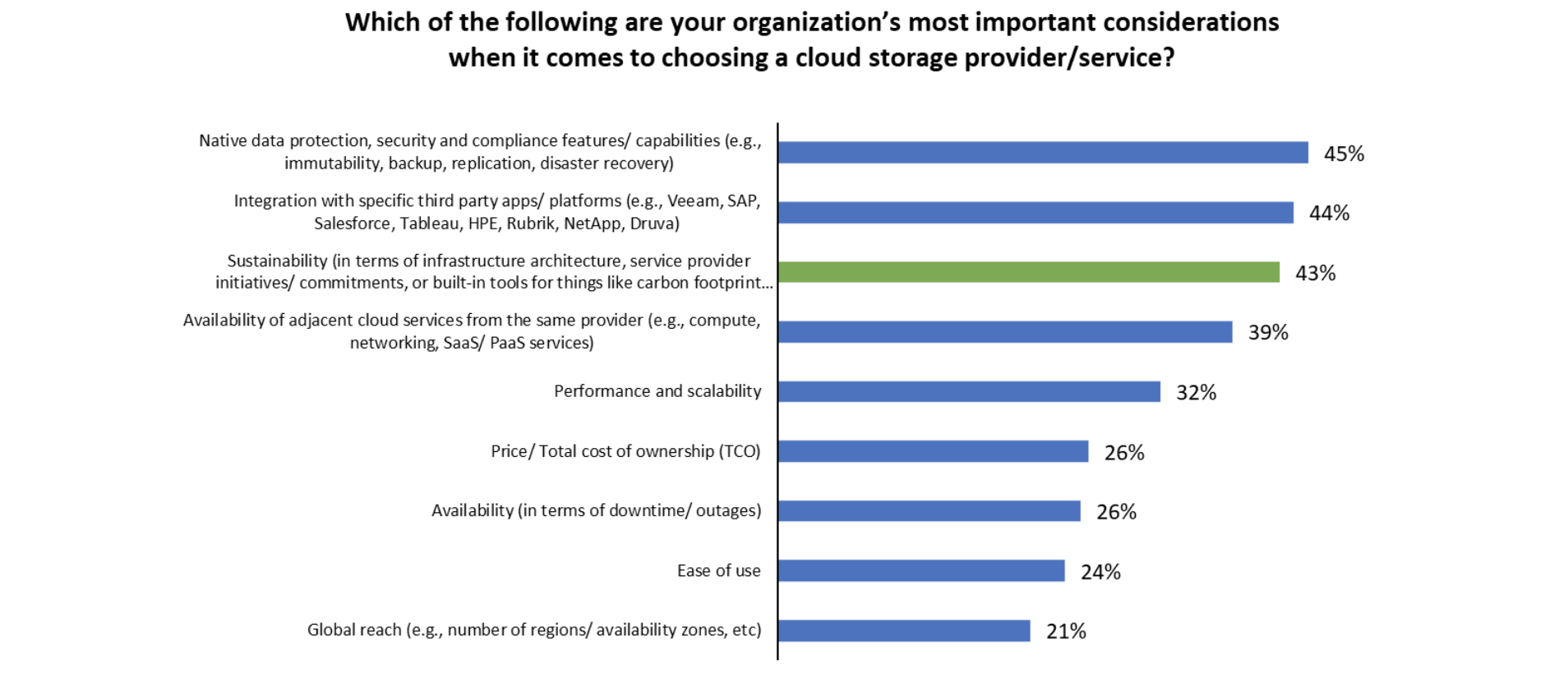SUSTAINABILITY
Sustainability in IT is Here to Stay
Sustainability in IT is Here to Stay
It’s no secret that sustainability initiatives in information technology have become top of mind for executives and IT professionals alike. In the Wasabi 2023 Global Cloud Storage Index, an independent survey of 1,000 IT decision-makers worldwide, we learned that sustainability is extremely important to cloud storage vendor selection considerations, with respondents ranking sustainability higher than other important factors such as price, performance, and scalability. In fact, C-level respondents ranked sustainability as their #1 criterion when considering a cloud storage provider. While minimizing one’s carbon footprint and the negative impact that IT operations can have on our environment is the all-important goal of sustainability, there are many other factors driving boardroom-level interest in such initiatives.
 Source: 2023 Wasabi Cloud Storage Index
Source: 2023 Wasabi Cloud Storage Index
Investor & CEO priorities behind sustainability initiatives
A 2022 survey conducted by Gartner concluded that environmental, social and governance (ESG) efforts were the third-highest priority for investors, behind profit and revenue. For the first time in the history of the survey, CEOs placed environmental sustainability in their top 10 strategic business priorities.
According to Mark Raskino, distinguished research VP at Gartner, “As business leaders feel the pressure from key stakeholders to do more on environmental sustainability, they are now treating the needed changes as opportunities to drive business efficiency and revenue growth.” ComputerWeekly also cited the Gartner survey, reporting that sustainability has become a competitive differentiator for CEOs in 2022 and 2023, landing at the same level as brand trust among respondents.
Macroeconomic trends driving sustainability
Regulatory pressures have played a significant role in driving the adoption of sustainability practices in IT. Governments around the world have been implementing policies and regulations aimed at reducing carbon emissions and promoting sustainable practices. For instance, the European Union has set ambitious targets for reducing greenhouse gas emissions, and many countries have implemented carbon pricing mechanisms to incentivize companies to reduce their carbon footprint. As a result, companies have been adopting sustainable IT practices to comply with regulations and avoid penalties.
According to Raskino and ComputerWeekly, the pandemic brought “deep societal trends” to the surface, such as the delicacy of global supply chains. Additionally, the Russian invasion of Ukraine exacerbated the macroeconomic factors CEOs face, such as inflation.
The growth of sustainability practices in IT has also been driven by technological innovations that have made sustainable practices more accessible and cost-effective. For example, the development of renewable energy sources, such as solar and wind power, has made it possible for businesses to generate their own renewable energy and reduce their reliance on fossil fuels. In addition, advances in data center design and management have made it possible to reduce energy consumption and increase efficiency.
Sustainability at Wasabi
Although there are various theories behind why sustainability has recently taken center stage, we’re happy to say that sustainability practices are here to stay. More and more companies have hired sustainability-focused team members and initiated sustainability campaigns, including Wasabi.
Sustainability is more than an initiative at Wasabi; it is literally baked into the design of our service. Wasabi Hot Cloud Storage is designed for optimal power consumption and data center space efficiency. The file system software that we built from the ground up maximizes the amount of data that can be stored on a single disk. This reduces the number of heat- and power-consuming disk drives required to store data. It also has the added benefit of increasing performance and lowering costs, which we are able to pass on to our customers.
To help our customers with their own sustainability initiatives, we recently launched the Wasabi cloud storage carbon footprint calculator, which estimates annual CO2e emissions based on the amount of data you store or plan to store in Wasabi.
It’s Earth Day. What can you do to reduce your IT carbon footprint?
So, what can you and your business do to continue innovating while keeping the environment in mind? Here a few things to consider:
- Virtualize your servers: Virtualization enables you to run multiple virtual machines on a single physical server, enabling you to reduce the number of physical machines and the space and energy needed to run them.
- Use energy-efficient hardware: Look for Energy Star-rated servers and storage devices, which are designed to use less power than their non-rated counterparts.
- Use energy-efficient cooling: Consider using free cooling, which relies on naturally cool air or water instead of traditional air conditioning units. This can significantly reduce energy consumption.
- Consolidate data centers: Consolidating multiple data centers into fewer, larger data centers can help reduce energy consumption and lower your carbon footprint.
- Use renewable energy: Consider using renewable energy sources, such as solar or wind power, to power your data center. Many cloud providers, including Wasabi, already use renewable energy sources to power their data centers.
- Implement data lifecycle management: Implement data lifecycle management and retention practices to ensure that data is stored only as long as necessary. This can extend the capacity of your existing storage, reduce waste, and lower energy consumption.
- Implement data deduplication: Data deduplication eliminates redundant data, which can significantly reduce the amount of storage needed and further extend capacity.
- Migrate to the cloud: Cloud providers typically have more energy-efficient data centers than most organizations can achieve on their own.

Free Gartner® Cloud Sustainability Report
This new research from Gartner can help you build a comprehensive environmental sustainability strategy by highlighting the criteria to evaluate cloud service providers. Download it free today!
Download Report

the bucket
It’s no secret that sustainability initiatives in information technology have become top of mind for executives and IT professionals alike. In the Wasabi 2023 Global Cloud Storage Index, an independent survey of 1,000 IT decision-makers worldwide, we learned that sustainability is extremely important to cloud storage vendor selection considerations, with respondents ranking sustainability higher than other important factors such as price, performance, and scalability. In fact, C-level respondents ranked sustainability as their #1 criterion when considering a cloud storage provider. While minimizing one’s carbon footprint and the negative impact that IT operations can have on our environment is the all-important goal of sustainability, there are many other factors driving boardroom-level interest in such initiatives.
 Source: 2023 Wasabi Cloud Storage Index
Source: 2023 Wasabi Cloud Storage Index
Investor & CEO priorities behind sustainability initiatives
A 2022 survey conducted by Gartner concluded that environmental, social and governance (ESG) efforts were the third-highest priority for investors, behind profit and revenue. For the first time in the history of the survey, CEOs placed environmental sustainability in their top 10 strategic business priorities.
According to Mark Raskino, distinguished research VP at Gartner, “As business leaders feel the pressure from key stakeholders to do more on environmental sustainability, they are now treating the needed changes as opportunities to drive business efficiency and revenue growth.” ComputerWeekly also cited the Gartner survey, reporting that sustainability has become a competitive differentiator for CEOs in 2022 and 2023, landing at the same level as brand trust among respondents.
Macroeconomic trends driving sustainability
Regulatory pressures have played a significant role in driving the adoption of sustainability practices in IT. Governments around the world have been implementing policies and regulations aimed at reducing carbon emissions and promoting sustainable practices. For instance, the European Union has set ambitious targets for reducing greenhouse gas emissions, and many countries have implemented carbon pricing mechanisms to incentivize companies to reduce their carbon footprint. As a result, companies have been adopting sustainable IT practices to comply with regulations and avoid penalties.
According to Raskino and ComputerWeekly, the pandemic brought “deep societal trends” to the surface, such as the delicacy of global supply chains. Additionally, the Russian invasion of Ukraine exacerbated the macroeconomic factors CEOs face, such as inflation.
The growth of sustainability practices in IT has also been driven by technological innovations that have made sustainable practices more accessible and cost-effective. For example, the development of renewable energy sources, such as solar and wind power, has made it possible for businesses to generate their own renewable energy and reduce their reliance on fossil fuels. In addition, advances in data center design and management have made it possible to reduce energy consumption and increase efficiency.
Sustainability at Wasabi
Although there are various theories behind why sustainability has recently taken center stage, we’re happy to say that sustainability practices are here to stay. More and more companies have hired sustainability-focused team members and initiated sustainability campaigns, including Wasabi.
Sustainability is more than an initiative at Wasabi; it is literally baked into the design of our service. Wasabi Hot Cloud Storage is designed for optimal power consumption and data center space efficiency. The file system software that we built from the ground up maximizes the amount of data that can be stored on a single disk. This reduces the number of heat- and power-consuming disk drives required to store data. It also has the added benefit of increasing performance and lowering costs, which we are able to pass on to our customers.
To help our customers with their own sustainability initiatives, we recently launched the Wasabi cloud storage carbon footprint calculator, which estimates annual CO2e emissions based on the amount of data you store or plan to store in Wasabi.
It’s Earth Day. What can you do to reduce your IT carbon footprint?
So, what can you and your business do to continue innovating while keeping the environment in mind? Here a few things to consider:
- Virtualize your servers: Virtualization enables you to run multiple virtual machines on a single physical server, enabling you to reduce the number of physical machines and the space and energy needed to run them.
- Use energy-efficient hardware: Look for Energy Star-rated servers and storage devices, which are designed to use less power than their non-rated counterparts.
- Use energy-efficient cooling: Consider using free cooling, which relies on naturally cool air or water instead of traditional air conditioning units. This can significantly reduce energy consumption.
- Consolidate data centers: Consolidating multiple data centers into fewer, larger data centers can help reduce energy consumption and lower your carbon footprint.
- Use renewable energy: Consider using renewable energy sources, such as solar or wind power, to power your data center. Many cloud providers, including Wasabi, already use renewable energy sources to power their data centers.
- Implement data lifecycle management: Implement data lifecycle management and retention practices to ensure that data is stored only as long as necessary. This can extend the capacity of your existing storage, reduce waste, and lower energy consumption.
- Implement data deduplication: Data deduplication eliminates redundant data, which can significantly reduce the amount of storage needed and further extend capacity.
- Migrate to the cloud: Cloud providers typically have more energy-efficient data centers than most organizations can achieve on their own.

Free Gartner® Cloud Sustainability Report
This new research from Gartner can help you build a comprehensive environmental sustainability strategy by highlighting the criteria to evaluate cloud service providers. Download it free today!
Download Report
featured articles
WASABI MEDIA & ENTERTAINMENT
April 10, 2024
Introducing Wasabi AiR: Unleash the Power of AI wit...
Introducing Wasabi AiR: Unleash the Power of AI wi...
TECHNOLOGY
April 23, 2024
Responsible AI Use: Lessons from an Industry Inside...
Responsible AI Use: Lessons from an Industry Insid...
TECH PARTNERS HEALTHCARE
April 18, 2024
Protect Your Research Data with Cost-friendly, Powe...
Protect Your Research Data with Cost-friendly, Pow...
TECH PARTNERS
April 11, 2024
Addressing AI Infrastructure Challenges with Wasabi...
Addressing AI Infrastructure Challenges with Wasab...
VIDEO SURVEILLANCE
April 9, 2024
